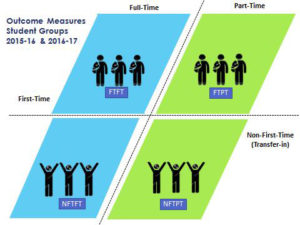The U.S. Department of Education’s National Center for Education Statistics (NCES) has made key changes to the Integrated Postsecondary Education Data System (IPEDS), which is used to measure success rates in higher education.
But while the changes reflect “significant progress,” they don’t go far enough in providing accurate data on outcomes for community college students, said Kent Phillipe, associate vice president for research and student success at the American Association of Community Colleges (AACC).
Up to now, IPEDS limited its reporting to first-time, full-time community college students who complete a degree or certificate within three years. That doesn’t reflect the reality of community colleges, where most students are part-time and take more than three years to graduate. Many two-year college students also transfer from other institutions of higher education, which wasn’t reflected in IPEDS.
New cohorts
The new IPEDS outcomes measures, released on Thursday, add three other cohorts: First-time, part-time students; non-first time full-time students, and non-first time part-time students. In another key change, the data now cover credentials earned within six and eight years. If students do not complete a degree or certificate within eight years, institutions are required to report whether they are still enrolled at that institution, whether they transferred out, or whether their enrollment status is unknown.
The new outcomes measures start with data collected in 2015-16.
According to the NCES, more measures will be added in 2018, including data on whether students are Pell Grant recipients; the type of award earned (certificate, associate degree or bachelor’s degree); and the status of students at four years after enrollment.
Looking at more than just first-time full-time students is “a step in the right direction,” said Andrew Nichols, director of higher education research and data analytics at the Education Trust. “What we had before for community colleges was subpar.” Limiting community college graduation rates to three years “was a terrible measure.”
He predicts the new data will reveal “a significant bump” in the success rates for most community colleges, although some could see marginal improvements.
VFA offers superior data
Despite the improvements in IPEDS, the data is not nearly as comprehensive as the data produced in AACC’s Voluntary Framework of Accountability.
“The VFA is more fleshed out. It provides a full set of metrics,” Phillipe said. The new IPEDS “is certainly better than what we had before, but it doesn’t help you understand the full picture. It doesn’t go far enough.”

The four cohorts in the new IPEDS measures. (Image: U.S. Education Department)
There’s still no transfer data for students who complete a degree, and it fails to provide data on subpopulations. Also, the outcome measures are new but the old measures are still collected and reported.
“If you really want to understand what is happening in community colleges, you need to better understand what’s happening within various sub-populations,” Phillipe said.
Also missing are data on whether transferring-in students already have a degree or certificate, and whether students change their full- or part-time status.
IPEDS still lumps all types of higher institutions together, comparing data for two- and four-year institutions, which Phillipe said isn’t appropriate.
“The VFA better reflects the mission of community colleges and the ability of community colleges to more appropriately tell their story and understand all the outcomes of students at their institutions,” he said.

